Assessment of Vulnerability to Erosion in Amazonian Beaches
Abstract
1. Introduction
2. Study Area: The Amazon Coast
2.1. Overview of the Amazon Coast
2.2. Geomorphological Setting and Offshore Conditions
2.3. Climatic Drivers and Hydrological Dynamics
2.4. The Study Area and Beach Characteristics
3. Methodology
Development of the Coastal Vulnerability Index (CVI)
4. Results
4.1. The Coastal Vulnerability Index (CVI)
4.2. Eastern Marajó Island (Sector II)
4.3. Continental Estuarine and Fluvio-Maritime (Sectors III and IV)
4.4. Atlantic Coast (Sector V)
5. Discussion
5.1. Geological Indicators
5.2. Physical Indicators
5.3. Environmental Indicators
5.4. Seafront Features
6. Summary and Conclusions
Author Contributions
Funding
Data Availability Statement
Acknowledgments
Conflicts of Interest
References
- Martinez, M.L.; Intralawan, A.; Vázquez, G.; Pérez-Maqueo, O.; Sutton, P.; Landgrave, R. The coasts of our world: Ecological, economic and social importance. Ecol. Econ. 2007, 63, 254–272. [Google Scholar] [CrossRef]
- Barbier, E.B.; Hacker, S.D.; Kennedy, C.; Koch, E.W.; Stier, A.C.; Silliman, B.R. The value of estuarine and coastal ecosystem services. Ecol. Monogr. 2011, 81, 169–193. [Google Scholar] [CrossRef]
- Prasad, D.H.; Kumar, N.D. Coastal erosion studies—A review. Int. J. Geosci. 2014, 5, 341–345. [Google Scholar] [CrossRef]
- Vousdoukas, M.I.; Ranasinghe, R.; Mentaschi, L.; Plomaritis, T.A.; Athanasiou, P.; Luijendijk, A.; Feyen, L. Sandy coastlines under threat of erosion. Nat. Clim. Change 2020, 10, 260–263. [Google Scholar] [CrossRef]
- Pranzini, E.; Williams, A.T. Coastal Erosion and Protection in Europe; Routledge: London, UK, 2013; 457p. [Google Scholar]
- Mentaschi, L.; Vousdoukas, M.I.; Pekel, J.F.; Voukouvalas, E.; Feyen, L. Global long-term observations of coastal erosion and accretion. Sci. Rep. 2018, 8, 12876. [Google Scholar] [CrossRef]
- Davis, R.A., Jr.; FitzGerald, D.M. Beaches and Coasts, 1st ed.; Blackwell Science Ltd.: Chichester, UK, 2004; p. 512. [Google Scholar] [CrossRef]
- Karymbalis, E.; Chalkias, C.; Chalkias, G.; Grigoropoulou, E.; Manthos, G.; Ferentinou, M. Assessment of the sensitivity of the southern coast of the Gulf of Corinth (Peloponnese, Greece) to sea-level rise. Cent. Eur. Geol. 2012, 4, 561–577. [Google Scholar] [CrossRef]
- Temmerman, S.; Meire, P.; Bouma, T.J.; Herman, P.M.; Ysebaert, T.; Vriend, H.J. Ecosystem-based coastal defence in the face of global change. Nature 2013, 504, 79–83. [Google Scholar] [CrossRef]
- Biel, R.G.; Hacker, S.D.; Ruggiero, P.; Cohn, N.; Seabloom, E.W. Coastal protection and conservation on sandy beaches and dunes: Context-dependent tradeoffs in ecosystem service supply. Ecosphere 2017, 8, e01791. [Google Scholar] [CrossRef]
- McLachlan, A.; Defeo, O.; Short, A.D. Characterising sandy beaches into major types and states: Implications for ecologists and managers. Estuar. Coast. Shelf Sci. 2018, 215, 152–160. [Google Scholar] [CrossRef]
- Antolinez, J.A.A.; Méndez, F.J.; Camus, P.; Vitousek, S.; González, E.M.; Ruggiero, P.; Barnard, P. A multiscale climate emulator for long-term morphodynamics (MUSCLE-morpho). J. Geophys. Res. Oceans 2016, 121, 775–791. [Google Scholar] [CrossRef]
- Harley, M.D.; Masselink, G.; Alegría-Arzaburu, R.A.; Valiente, N.G.; Scott, T. Single extreme storm sequence can offset decades of shoreline retreat projected to result from sea-level rise. Commun. Earth Environ. 2022, 3, 112. [Google Scholar] [CrossRef]
- Thakur, S.; Mondal, I.; Bar, S.; Nandi, S.; Ghosh, P.B.; Das, P.; De, T.K. Shoreline changes and its impact on the mangrove ecosystems of some islands of Indian Sundarbans, North-East coast of India. J. Clean. Prod. 2021, 284, 124764. [Google Scholar] [CrossRef]
- Phillips, M.R.; Jones, A.L. Erosion and tourism infrastructure in the coastal zone: Problems, consequences and management. Tour. Manag. 2006, 27, 517–524. [Google Scholar] [CrossRef]
- Roig-Munar, F.X.; Mir-Gual, M.; Rodríguez-Perea, A.; Pons, G.X.; Martín-Prieto, J.A.; Gelabert, B.; Blázquez-Salom, M. Beaches of Ibiza and Formentera (Balearic Islands): A classification based on their environmental features, tourism use and management. J. Coast. Res. 2013, 65, 1850–1855. [Google Scholar] [CrossRef]
- Splinter, K.D.; Carley, J.T.; Golshani, A.; Tomlinson, R. A relationship to describe the cumulative impact of storm clusters on beach erosion. Coast. Eng. 2014, 83, 49–55. [Google Scholar] [CrossRef]
- Harley, M.D.; Turner, I.L.; Kinsela, M.A.; Middleton, J.H.; Mumford, P.J.; Splinter, K.D.; Short, A.D. Extreme coastal erosion enhanced by anomalous extratropical storm wave direction. Sci. Rep. 2017, 7, 6033. [Google Scholar] [CrossRef]
- Ciavola, P.; Coco, G. Coastal Storms: Processes and Impacts; John Wiley & Sons: Hoboken, NJ, USA, 2004. [Google Scholar] [CrossRef]
- Pereira, L.C.C.; Guimarães, D.O.; Ribeiro, M.J.S.; Costa, R.M.; Souza-Filho, P.W.M. Use and occupation in Bragança littoral, Brazilian Amazon. J. Coast. Res. 2007, SI 50, 1116–1120. [Google Scholar] [CrossRef]
- Pereira, L.C.C.; Sousa-Felix, R.C.; Costa, R.M.; Jimenez, J.A. Challenges of the recreational use of Amazon beaches. Ocean Coast. Manag. 2018, 165, 52–62. [Google Scholar] [CrossRef]
- Sharples, C. Indicative Mapping of Tasmanian Coastal Geomorphic Vulnerability to Sea-Level Rise Using GIS Line Map of Coastal Geomorphic Attributes; Department of Primary Industries & Water: Hobart, Australia, 2016.
- Narra, P.; Coelho, C.; Sancho, F.; Escudero, M.; Silva, R. Coastal hazard assessments for sandy coasts: Appraisal of five methodologies. J. Coast. Res. 2019, 35, 574–589. [Google Scholar] [CrossRef]
- Rodríguez-Rosales, B.; Abreu, D.; Ortiz, R.; Becerra, J.; Cepero-Acán, A.E.; Vázquez, M.A.; Ortiz, P. Risk and vulnerability assessment in coastal environments applied to heritage buildings in Havana (Cuba) and Cadiz (Spain). Sci. Total Environ. 2021, 750, 141617. [Google Scholar] [CrossRef]
- Gornitz, V.M. Vulnerability of the East Coast USA to future sea level rise. J. Coast. Res. 1990, 9, 201–237. [Google Scholar]
- Kumar, A.; Kunte, P.D. Coastal vulnerability assessment for Chennai, east coast of India using geospatial techniques. Nat. Hazards 2012, 64, 853–872. [Google Scholar] [CrossRef]
- Pantusa, D.; D’Alessandro, F.; Riefolo, L.; Principato, F.; Tomasicchio, G.R. Application of a coastal vulnerability index. A case study along the Apulian Coastline, Italy. Water 2018, 10, 1218. [Google Scholar] [CrossRef]
- Pereira, L.C.C.; Vila-Concejo, A.; Costa, R.M.; Short, A.D. Managing physical and anthropogenic hazards on macrotidal Amazon beaches. Ocean Coast. Manag. 2014, 96, 149–162. [Google Scholar] [CrossRef]
- Pereira, L.C.C.; Vila-Concejo, A.; Short, A.D. Coastal Morphodynamic Processes on the Macro-Tidal Beaches of Pará State Under Tidally Modulated Wave Conditions. In Brazilian Beach Systems; Short, A., Klein, A., Eds.; Coastal Research Library; Springer: Cham, Switzerland, 2016; Volume 17. [Google Scholar] [CrossRef]
- Anthony, J.E.; Gardel, A.; Proisy, C.; Fromard, F.; Gensac, E.; Peron, C.; Walcker, R.; Lesourd, S. The role of fluvial sediment supply and river-mouth hydrology in the dynamics of the muddy Amazon-dominated Amapá-Guianas coast South America: A three-point research agenda. J. S. Am. Earth Sci. 2013, 44, 18–24. [Google Scholar] [CrossRef]
- Anthony, J.E.; Gardel, A.; Gratiot, N. Fluvial sediment supply, mud banks, cheniers and the morphodynamics of the coast of South America between the Amazon and Orinoco river mouths. Geol. Soc. Lond. Spéc. Publ. 2013, 388, 533–560. [Google Scholar] [CrossRef]
- Isaac, V.J.; Barthem, R.B. Os Recursos Pesqueiros da Amazônia Brasileira; PR-MCT/CNPq Museu Paraense Emílio Goeldi: Belém, Brazil, 1995. [Google Scholar]
- Meade, R.H.; Rayol, J.M.; Conceicão, S.C.; Natividade, J.R. Backwater effects in the Amazon River basin of Brazil. Environ. Geol. Water Sci. 1991, 18, 105–114. [Google Scholar] [CrossRef]
- Moura, R.L.; Amado-Filho, G.M.; Moraes, F.C.; Brasileiro, P.S.; Salomon, P.S.; Mahiques, M.M.; Thompson, F.L. An extensive reef system at the Amazon River mouth. Sci. Adv. 2016, 2, e1501252. [Google Scholar] [CrossRef]
- Anthony, J.E.; Gardel, A.; Gratiot, N.; Proisy, C.; Allison, M.A.; Dolique, F.; Fromard, F. The Amazon-influenced muddy coast of South America: A review of mud-bank–shoreline interactions. Earth Sci. Rev. 2010, 103, 99–121. [Google Scholar] [CrossRef]
- Dunne, T.; Mertes, L.A.K.; Meade, R.; Richey, J.E.; Forsberg, B.R. Exchanges of sediment between the floodplain and channel of the Amazon in Brazil. Geol. Soc. Am. Bull. 1998, 110, 450–467. [Google Scholar] [CrossRef]
- Kjerfve, B.; Lacerda, L.D. Mangroves of Brazil. In Conservation and Sustainable Utilization of Mangrove Forests in Latin America and Africa Regions; Lacerda, L.D., Ed.; International Society for Mangrove Ecosystems: Okinawa, Japan, 1993; pp. 245–272. [Google Scholar]
- Souza-Filho, P.W.M.; Morais Tozzi, H.A.; El-Robrini, M. Geomorphology, land-use and environmental hazards in Ajuruteua macrotidal sandy beach, northern Brazil. J. Coast. Res. 2003, 580–589. Available online: https://www.jstor.org/stable/40928810 (accessed on 25 June 2025).
- Franzinelli, E. Evolution of the geomorphology of the coast of the State of Pará Brazil. In Évolution des Littoraux de Guyane et de la Zone Caraïbe Méridionale Pendant le Quaternaire; Prost, M.T., Ed.; ORSTOM: Paris, France, 1992; pp. 203–230. [Google Scholar]
- National Oceanic and Atmospheric Administration-NOAA. Buoy Data—41041 Middle Atlantic. 2024. Available online: https://ncei.noaa.gov/access/marine-environmental-buoy-database/41041.html (accessed on 30 November 2024).
- Figueroa, S.N.; Nobre, C.A. Precipitations distribution over central and western tropical South America. Climanálise 1990, 5, 36–45. [Google Scholar]
- Marengo, J.A. Interannual variability of deep convection over the tropical South American sector as deduced from ISCCP C2 data. Int. J. Climatol. 1995, 15, 995–1010. [Google Scholar] [CrossRef]
- Agência Bacional de Águas—ANA. 2024. Available online: https://www.gov.br/ana/pt-br (accessed on 30 November 2024).
- Instituto Nacional de Meteorologia—INMET. Monitoramento das Estações Automáticas. 2024. Available online: http://www.inmet.gov.br/sonabra/maps/automaticas.php (accessed on 30 November 2024).
- Centro de Hidrografia da Marinha—CHM. Tábuas de Maré. 2024. Available online: www.marinha.mil.br/chm/dados-do-segnav/dados-de-mare-mapa (accessed on 30 November 2024).
- Thieler, E.R.; Hammar-Klose, E.S. National Assessment of Coastal Vulnerability to Sea-Level Rise: Preliminary Results for the US Atlantic Coast (No. 99-593); US Geological Survey: Reston, VA, USA, 1999.
- López Royo, M.; Ranasinghe, R.; Jiménez, J.A. A rapid, low-cost approach to coastal vulnerability assessment at a national level. J. Coast. Res. 2016, 32, 932–945. [Google Scholar] [CrossRef]
- Mangor, K.; Drønen, N.K.; Kærgaard, K.H.; Kristensen, S.E. Shoreline Management Guidelines; DHI: London, UK, 2004. [Google Scholar]
- Bush, D.M.; Neal, W.J.; Young, R.S.; Pilkey, O.H. Utilization of geoindicators for rapid assessment of coastal-hazard risk and mitigation. Ocean Coast. Manag. 1999, 42, 647–670. [Google Scholar] [CrossRef]
- Tragaki, A.; Gallousi, C.; Karymbalis, E. Coastal hazard vulnerability assessment based on geomorphic, oceanographic and demographic parameters: The case of the Peloponnese (Southern Greece). Land 2018, 7, 56. [Google Scholar] [CrossRef]
- Pereira, L.; Concejo, A.V.; Trindade, W. Tidal modulation. In Sandy Beach Morphodynamics; Elsevier: Amsterdam, The Netherlands, 2020; pp. 87–101. [Google Scholar] [CrossRef]
- Browning, T.N.; Sawyer, D.E. Vulnerability to watershed erosion and coastal deposition in the tropics. Sci. Rep. 2021, 11, 885. [Google Scholar] [CrossRef]
- Sousa, P.H.G.O. Vulnerabilidade à Erosão Costeira no Litoral de São Paulo: Interação Entre Processos Costeiros e Atividades Antrópicas. Ph.D. Thesis, Instituto Oceanográfico, Universidade de São Paulo, São Paulo, Brazil, 2013. [Google Scholar]
- Silva, I.R.; Pereira, L.C.C.; Trindade, W.N.; Magalhaes, A.; Costa, R.M. Natural and anthropogenic processes on the recreational activities in urban Amazon beaches. Ocean Coast. Manag. 2013, 76, 75–84. [Google Scholar] [CrossRef]
- Alexandrakis, G.; Poulos, S. An holistic approach to beach erosion vulnerability assessment. Sci. Rep. 2014, 4, 6078. [Google Scholar] [CrossRef]
- Nageswara Rao, K.; Subraelu, P.; Venkateswara Rao, T.; Hema Malini, B.; Ratheesh, R.; Bhattacharya, S.; Ajai. Sea-level rise and coastal vulnerability: An assessment of Andhra Pradesh coast, India through remote sensing and GIS. J. Coast. Conserv. 2008, 12, 195–207. [Google Scholar] [CrossRef]
- Andrade, T.S.; Sousa, P.H.G.O.; Siegle, E. Vulnerability to beach erosion based on a coastal processes approach. Appl. Geogr. 2019, 102, 12–19. [Google Scholar] [CrossRef]
- Bozzeda, F.; Ortega, L.; Costa, L.L.; Fanini, L.; Barboza, C.A.; McLachlan, A.; Defeo, O. Global patterns in sandy beach erosion: Unraveling the roles of anthropogenic, climatic and morphodynamic factors. Front. Mar. Sci. 2023, 10, 1270490. [Google Scholar] [CrossRef]
- Pendleton, E.A.; Thieler, E.R.; Williams, S.J.; Beavers, R.L. Coastal Vulnerability Assessment of Padre Island National Seashore (PAIS) to Sea-Level Rise (No. 2004-1090); US Geological Survey: Reston, VA, USA, 2004.
- Pereira, L.C.C.; Silva, N.I.S.; Costa, R.M.; Asp, N.E.; Costa, K.G.; Vila-Concejo, A. Seasonal changes in oceanographic processes at an equatorial macrotidal beach in northern Brazil. Cont. Shelf Res. 2012, 43, 95–106. [Google Scholar] [CrossRef]
- Oliveira, S.; Moura, D.; Horta, J.; Nascimento, A.; Gomes, A.; Veiga-Pires, C. The morphosedimentary behaviour of a headland–beach system: Quantifying sediment transport using fluorescent tracers. Mar. Geol. 2017, 388, 62–73. [Google Scholar] [CrossRef]
- Pessoa, R.M.C.; Pereira, L.C.C.; Sousa, R.C.; Costa, R.A.M. Water Quality during the Recreational High Season for a Macrotidal Beach (Ajuruteua, Pará, Brazil). J. Coast. Res. 2016, 75, 1222–1226. [Google Scholar] [CrossRef]
- Pessoa, R.M.C.; Jiménez, J.A.; Costa, R.M.; Pereira, L.C.C. Federal conservation units in the Brazilian amazon coastal zone: An adequate approach to control recreational activities? Ocean Coast. Manag. 2019, 178, 104856. [Google Scholar] [CrossRef]
- Pereira, L.C.C.; Pessoa, R.M.C.; Sousa-Felix, R.C.; Dias, A.B.B.; Costa, R.M. How sustainable are recreational practices on Brazilian Amazon beaches? J. Outdoor Recreat. Tour. 2024, 45, 100741. [Google Scholar] [CrossRef]
- Sousa, R.C.; Pereira, L.C.C.; Silva, N.I.S.; Oliveira, S.M.O.; Pinto, K.S.T.; Costa, R.M. Recreational carrying capacity of three Amazon macrotidal beaches during the peak vacation season. J. Coast. Res. 2011, 64, 1292–1296. [Google Scholar]
- Sousa, P.H.; Siegle, E.; Tessler, M.G. Vulnerability assessment of Massaguaçú beach (SE Brazil). Ocean Coast. Manag. 2013, 77, 24–30. [Google Scholar] [CrossRef]
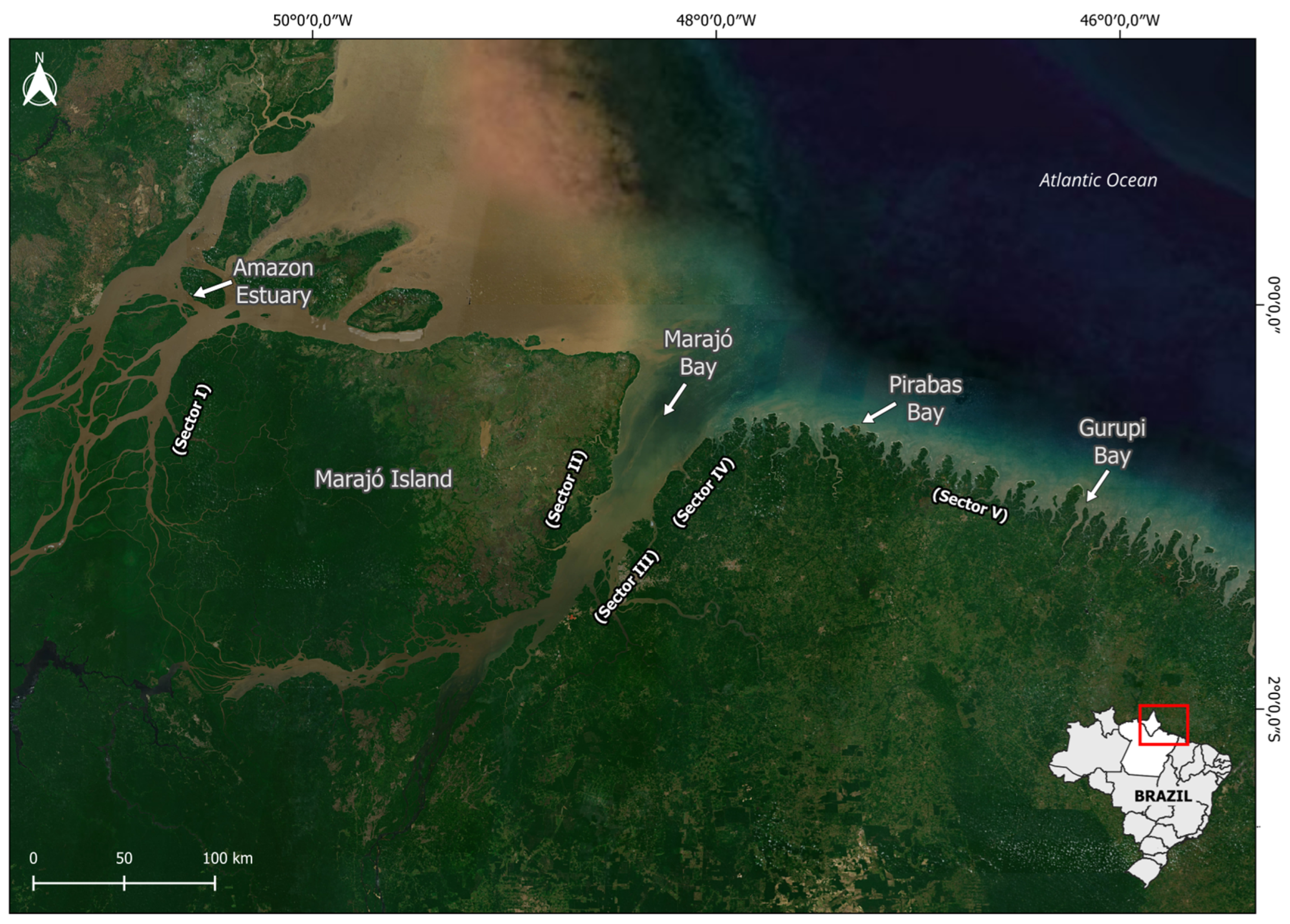
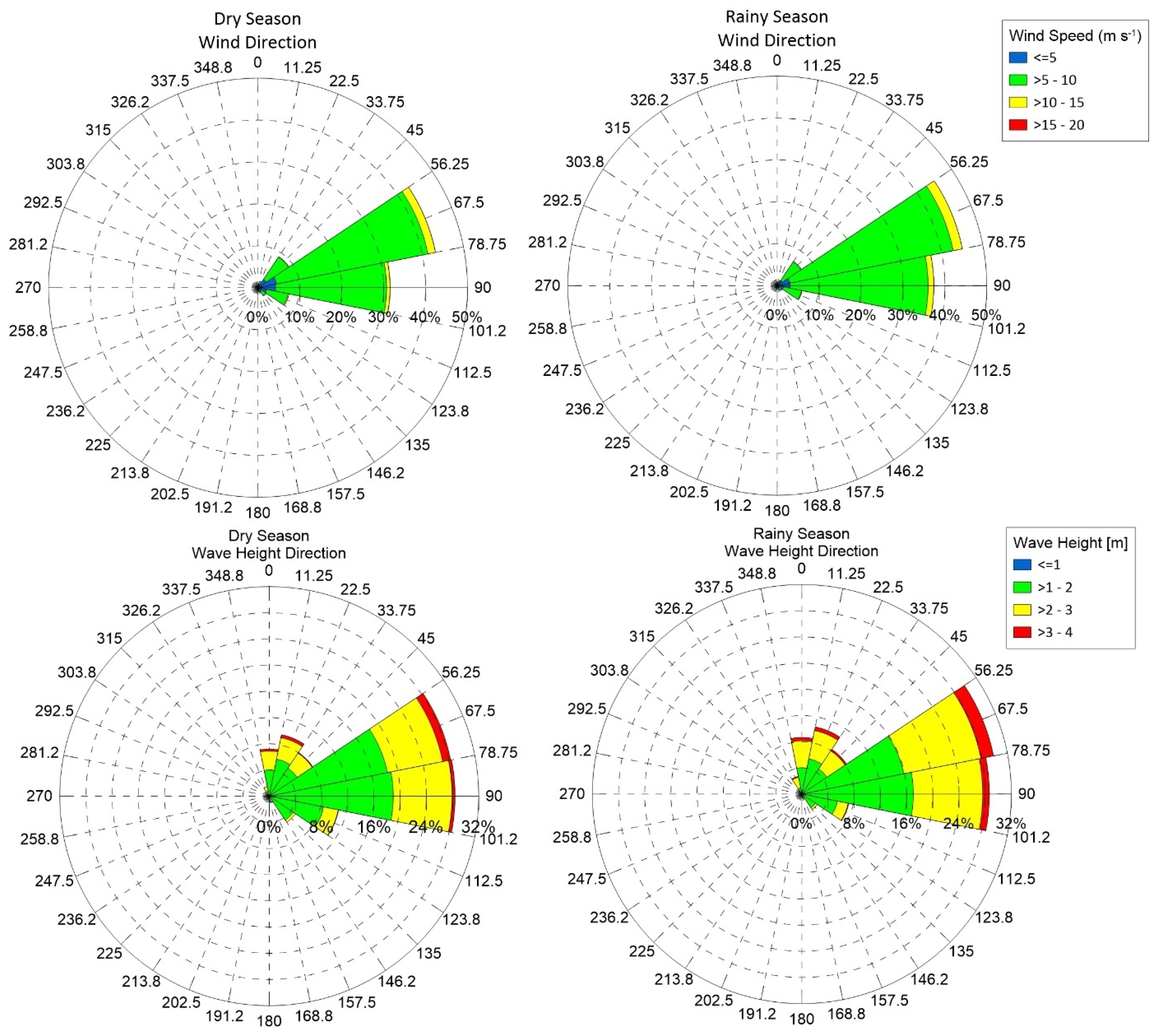





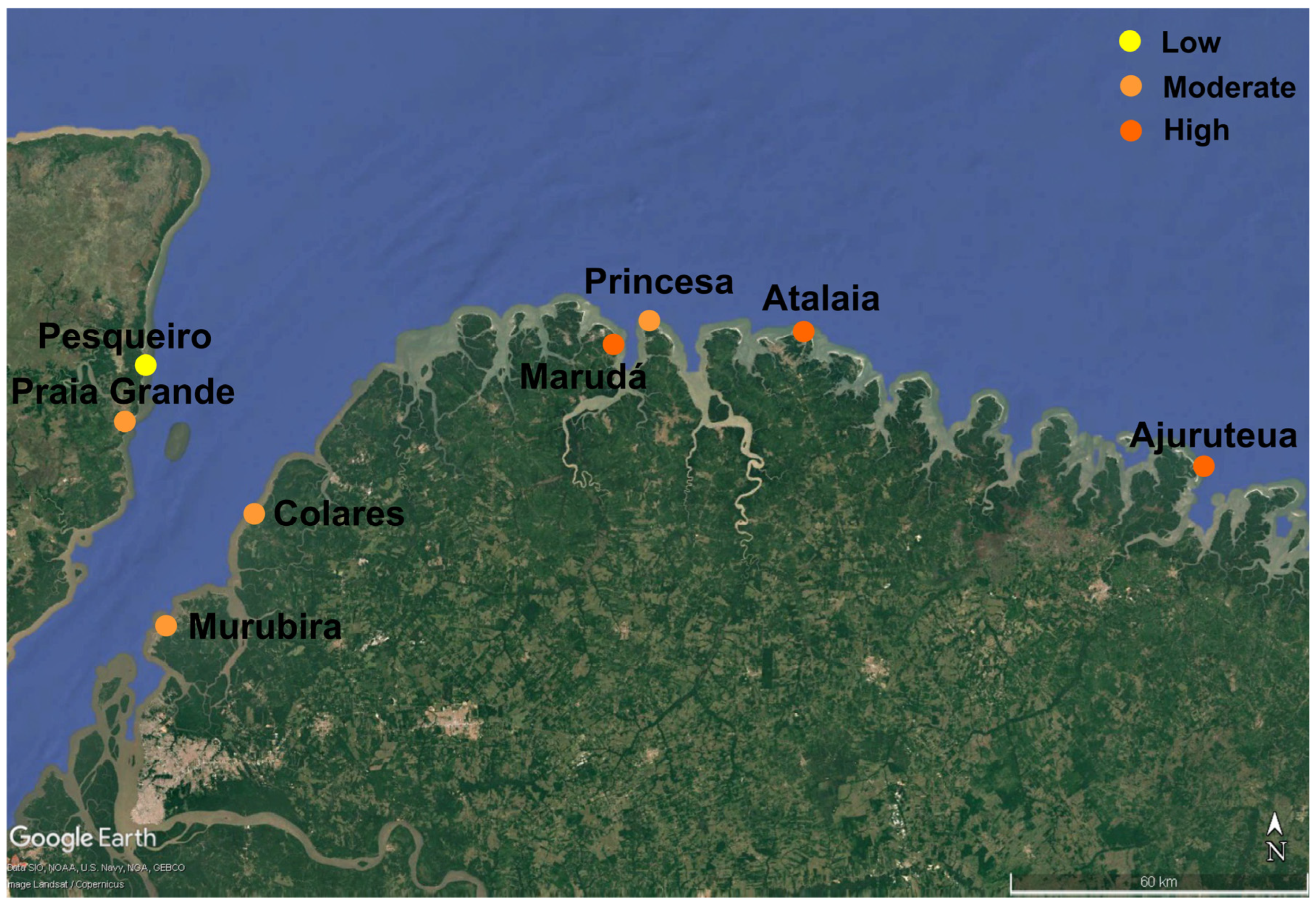
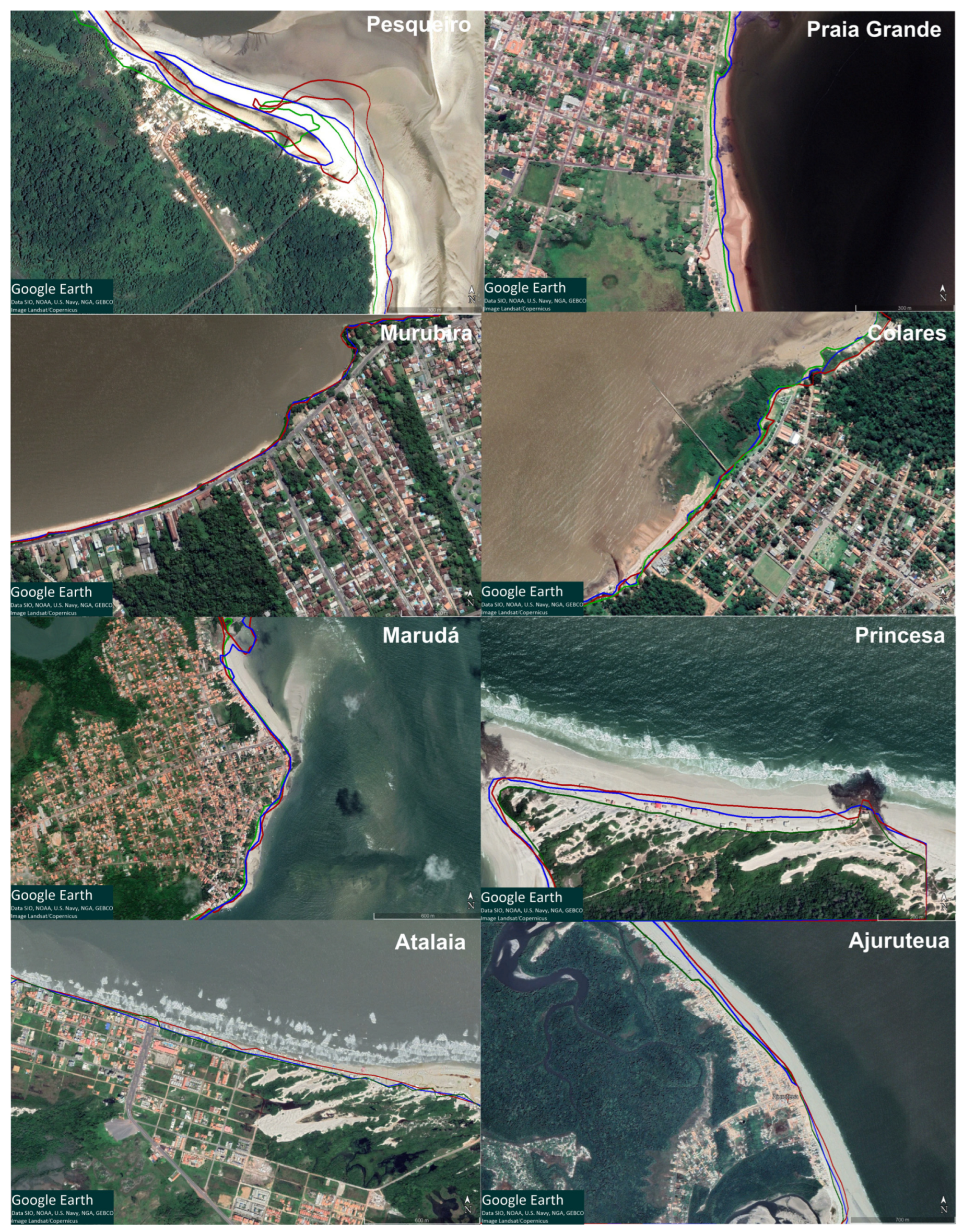
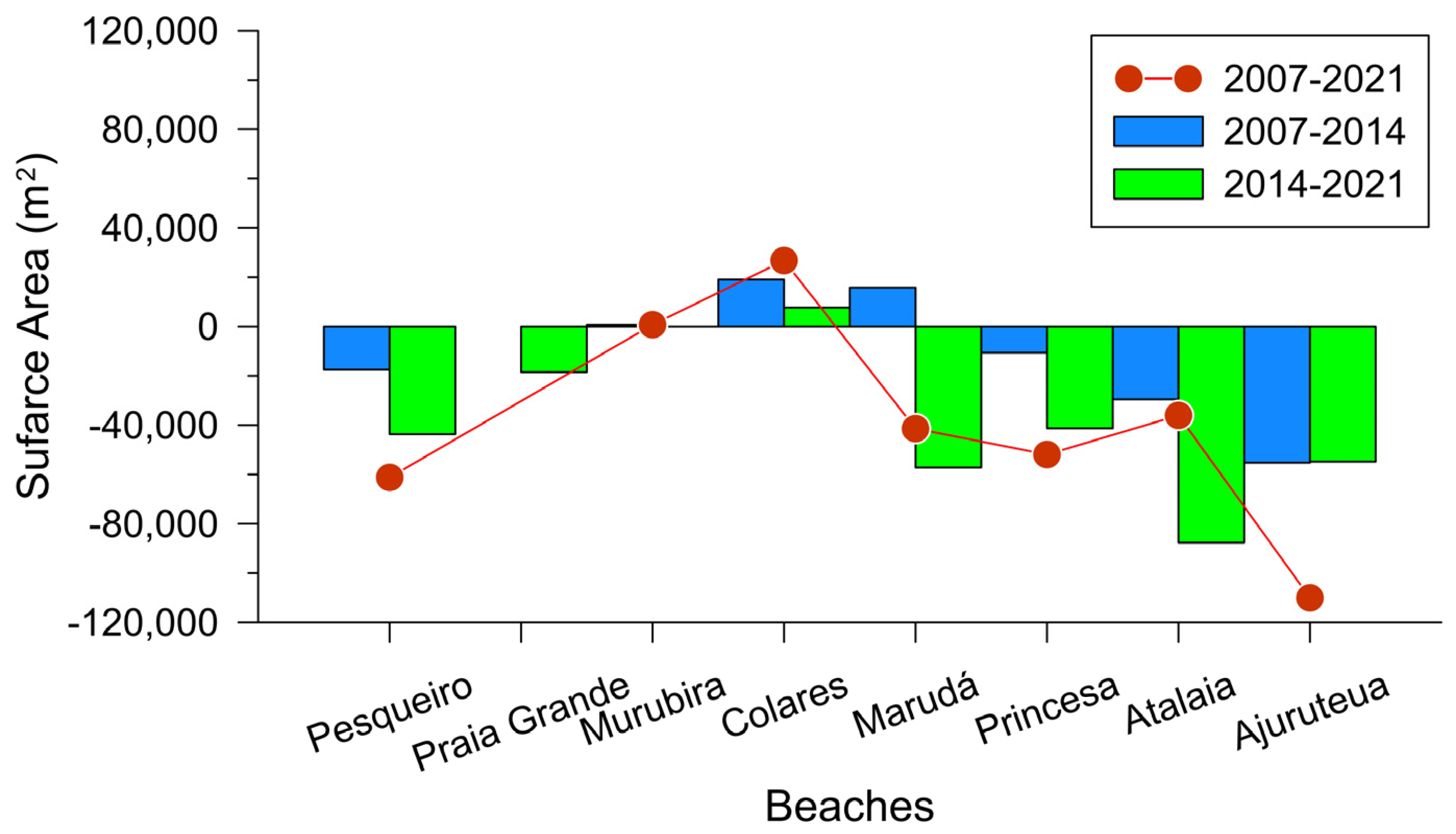
| Sub-Indexes | Indicators | Methodology |
|---|---|---|
| Geology | Geomorphology | Field campaigns (direct observation), Google Earth satellite images, and literature review. |
| Beach slope | Field campaigns. Two topographic levelling campaigns were carried out on each beach, from the dunes, backshore area, or promenade to the nearshore area (up to 1.5 me deep, relative to the spring low tide level). | |
| Beach exposure | Field campaigns (direct observation and hydrodynamic measures), Google Earth satellite images, and literature review. Hydrodynamics (tidal elevation and significant wave height—Hs) were collected using a mooring mounted on the bottom at a depth of 4.7 m below the MWL, to which wave and tide data loggers (TWR 2050) were attached. Wave sampling was carried out on the basis of 512 samples at a burst rate of 4 Hz, with sampling periods of 10 min. Tidal water level data was obtained every 2 s, and average values were measured every 10 min. | |
| Terrain elevation | Satellite imagery from Google Earth | |
| Physical | Wave climate Hs95%/Hs | Field campaigns. Significant wave height (Hs) were collected using a bottom-mounted mooring at a depth of 4.7 m below MWL, to which a wave data logger (TWR 2050) was attached. Wave sampling was based on 512 samples at a burst rate of 4 Hz with sampling periods of 10 min duration. Offshore significant wave heights (Hos) (average height of the highest one-third of all waves measured), periods (Tp) (defined as the wave period associated with the most energetic waves in the total wave spectrum at a specific point), and directions (θ) were obtained from National Data Buoy Center (NDBC), which holds data from NOAA (station 41041) |
| Spring tidal range | Tidal range was obtained using a bottom-mounted mooring at a depth of 4.7 m below MWL, to which a tide data logger (TWR 2050) was attached. Tidal water level data was obtained every 2 s, and mean values were measured every 10 min. | |
| Rainfall level | Monthly precipitation data was provided by the INMET (meteorological stations located at Tracuateua and Belém). | |
| Wave orientation | The wave direction was obtained from NOAA (station 41041), the beach orientation was determined using Google Earth, and the angle of rotation of the orientation for this shallow angle was obtained using a software program. | |
| Environmental | Conservation status of the dunes | Field campaigns (direct observation). |
| Conservation status of the mangrove | Field campaigns (direct observation). | |
| Protect area | Literature review. | |
| Seafront features | Development level | Satellite imagery from Google Earth and field campaign (direct observation). |
| Territorial occupation | Satellite imagery from Google Earth and field campaign (direct observation). | |
| Erosion indicators | Field campaign (direct observation). |
| Sub-Index | Indicators | Score | ||||
|---|---|---|---|---|---|---|
| 1-Very Low | 2-LOW | 3-Moderate | 4-High | 5-Very High | ||
| Geology (GE) | Geomorphology (GM) | Rocky, cliffed coasts | Medium cliffs and indented coasts | Low cliffs | Estuary and lagoon | Barrier–beach ridge, sandy beaches, muddy or sandy flats bounded by dunes, deltas, mangrove environments |
| Beach slope (BS) | >0.12° | 0.08–0.12° | 0.04–0.08° | 0.02–0.04° | <0.02° | |
| Beach exposure (BE) | Beaches protected by breakwater or natural barrier and influenced by high tidal modulation | Beaches partially protected by natural barrier and with moderate modulation tidal modulation | Beaches partially protected inside the bays, receiving fetch-limited waves | Beaches partially exposed and marked for no modulation of the breaking wave climate | Exposed beaches without protective structures and exhibit no modulation of the breaking wave climate | |
| Terrain elevation (TE) | >6 m (estuarine beaches) > 9 m (oceanic beaches) | -- | 3 to 6 m (estuarine beaches) 6 to 9 m (oceanic beaches) | -- | <3 m (estuarine beaches) and <6 (oceanic beaches) | |
| Physical (PH) | Wave climate (WC) | <0.65 | 0.65–0.75 | 0.75–1.0 | 1.0–1.5 | >1.5 |
| Spring tidal range (sTR) | <1.0 m | 1.0–2.0 m | 2.0–4.0 m | 4.0–6.0 m | >6.0 m | |
| Rainfall level (cumulative three-month - RL) | <0–49.9 mm | 50.0–199.9 mm | 200.0–324.9 mm | 325.0–499.9 mm | >500 mm | |
| Wave orientation (WO) | 75°–90° 91°–105° | -- | 60°–74° 106°–120° | -- | 45°–59° 121°–135° | |
| Environmental (EN) | Conservation status of the dunes (CD) | Preserved and vegetated | -- | Partially affected: not vegetated dunes, territorial occupation | -- | Suppressed |
| Conservation status of the mangrove forest (CM) | Dense, mature mangroves with no evidence of erosion | -- | Partially affected: plants with exposed roots, territorial occupation | -- | Little or no trees or leaning trees | |
| Protect area (PA) | Within a protected area | -- | Adjacent to a protected area | -- | Far from protected area | |
| Seafront features (SF) | Development level (DL) | Rural | Semi-urban process | Semi-urban | Urbanization process | Urban |
| Territorial occupation (TO) | <10% | 10–30% | 30–50% | 50–70% | >70% | |
| Erosion indicators * (EI) | None | -- | 1 to 4 | -- | >5 | |
| Components | Indicators | Pesqueiro | Praia Grande | Murubira | Colares | Marudá | Princesa | Atalaia | Ajuruteua |
|---|---|---|---|---|---|---|---|---|---|
| Geology | Geomorphology | 5 | 3 | 3 | 3 | 5 | 5 | 5 | 5 |
| Beach slope | 4 | 3 | 3 | 3 | 4 | 5 | 5 | 5 | |
| Beach exposure | 3 | 3 | 3 | 3 | 3 | 1 | 2 | 1 | |
| Terrain elevation | 3 | 1 | 1 | 3 | 3 | 5 | 5 | 5 | |
| Physical | Wave climate | 4 | 4 | 4 | 4 | 5 | 5 | 5 | 5 |
| Spring tidal range | 3 | 3 | 3 | 3 | 5 | 5 | 5 | 5 | |
| Rainfall level | 5 | 5 | 5 | 5 | 5 | 5 | 5 | 5 | |
| Wave orientation | 5 | 5 | 5 | 5 | 5 | 5 | 5 | 5 | |
| Environmental | Conservation status of the dunes | 1 | 3 | 3 | 1 | 3 | 1 | 3 | 3 |
| Conservation status of the mangrove | 1 | 3 | 3 | 1 | 3 | 1 | 3 | 3 | |
| Protect area | 1 | 5 | 5 | 5 | 5 | 1 | 3 | 3 | |
| Seafront features | Development level | 1 | 3 | 3 | 2 | 3 | 1 | 3 | 2 |
| Territorial occupation | 2 | 4 | 5 | 4 | 5 | 2 | 5 | 4 | |
| Erosion indicators | 3 | 5 | 5 | 4 | 5 | 3 | 5 | 5 | |
| CVI | 2.9 | 3.6 | 3.6 | 3.3 | 4.2 | 3.2 | 4.2 | 4.0 | |
Disclaimer/Publisher’s Note: The statements, opinions and data contained in all publications are solely those of the individual author(s) and contributor(s) and not of MDPI and/or the editor(s). MDPI and/or the editor(s) disclaim responsibility for any injury to people or property resulting from any ideas, methods, instructions or products referred to in the content. |
© 2025 by the authors. Licensee MDPI, Basel, Switzerland. This article is an open access article distributed under the terms and conditions of the Creative Commons Attribution (CC BY) license (https://creativecommons.org/licenses/by/4.0/).
Share and Cite
Pereira, R.L.M.C.; Mösso, C.; Pereira, L.C.C. Assessment of Vulnerability to Erosion in Amazonian Beaches. Geographies 2025, 5, 29. https://doi.org/10.3390/geographies5030029
Pereira RLMC, Mösso C, Pereira LCC. Assessment of Vulnerability to Erosion in Amazonian Beaches. Geographies. 2025; 5(3):29. https://doi.org/10.3390/geographies5030029
Chicago/Turabian StylePereira, Remo Luan Marinho Costa, Cesar Mösso, and Luci Cajueiro Carneiro Pereira. 2025. "Assessment of Vulnerability to Erosion in Amazonian Beaches" Geographies 5, no. 3: 29. https://doi.org/10.3390/geographies5030029
APA StylePereira, R. L. M. C., Mösso, C., & Pereira, L. C. C. (2025). Assessment of Vulnerability to Erosion in Amazonian Beaches. Geographies, 5(3), 29. https://doi.org/10.3390/geographies5030029







